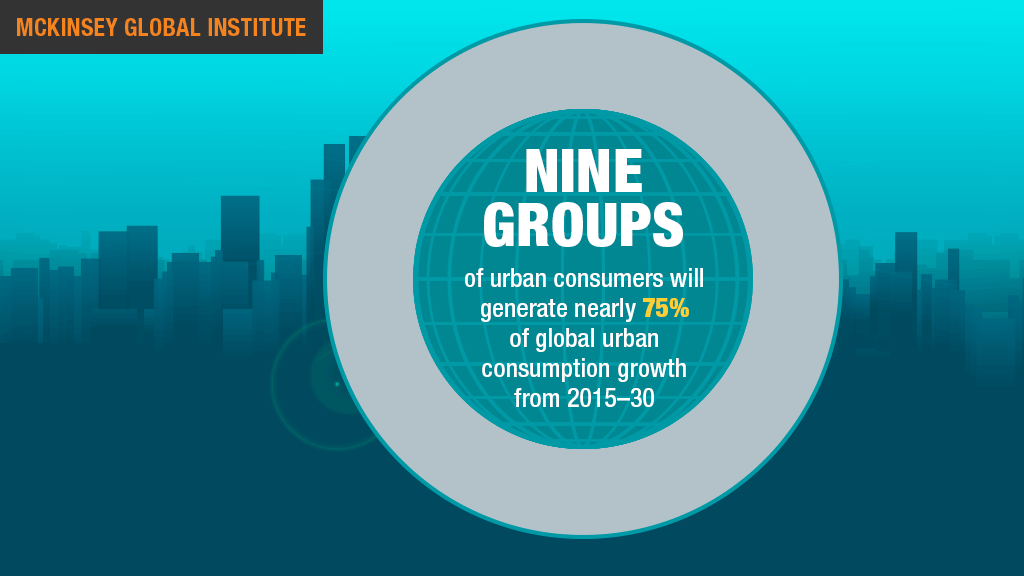Until the turn of this century, population growth generated more than half of all global consumption. But between 2015 and 2030, three-quarters of global consumption growth will be driven by individuals spending more. This shift has profound implications for companies. What’s now important are emerging demographics: the latest report from the McKinsey Global Institute (MGI) finds that nine groups will generate three-quarters of global urban consumption growth to 2030, and just three of these will generate half of consumption growth and have the power to reshape global consumer markets over the next 15 years.

These three demographic groups will generate half of all global urban consumption growth through 2030:
1. The retiring and elderly in developed economies
This group will grow by more than one-third in number, from 164 million in 2015 to 222 million in 2030. It will generate 51 percent of urban consumption growth in developed countries and 19 percent of global urban consumption growth. To give an idea of its dominance, the 60-plus age group will account for 60 percent of total urban consumption growth in Western Europe and Northeast Asia (Japan and South Korea). A closer look at this cohort reveals several findings:
- These consumers spend more per head than younger people, largely because of heavy spending on healthcare. But their consumption is about more than healthcare. In the United States, this group will contribute more than 40 percent of consumption growth in housing, transport, and entertainment.
- By 2030, we expect to see a wider variation in purchasing power among the elderly than we see today. While many in the 60-plus age group are wealthy, others have not saved sufficiently to see them through retirement. Income inequality in the United States among those aged 65 and older continues to rise.
- People over 50 bought nearly two-thirds of the new cars sold in the United States in 2011.
- The elderly increasingly want to “age in place.” A decade ago, those aged 55 and older accounted for less than one-third of all US spending on home improvement. By 2011, this share was more than 45 percent.
2. China’s working-age population
By 2030, this group will expand by 20 percent—an additional 100 million people—and per capita consumption is expected to more than double. By 2030, China’s working-age population will account for 12 cents of every dollar spent in cities worldwide. This group has the potential to reshape global consumption just as the West’s baby boomers, the richest generation in history, did in their prime years. Some highlights from MGI’s research:
- China is expected to spend 12.5 percent of all consumption growth on education for those under 30—higher than any other country apart from Sweden (12.6 percent).
- The 2016 McKinsey Global Sentiment Survey of more than 22,000 consumers finds that nearly 30 percent of these Chinese consumers are willing to pay more for new and innovative household products—double the share of their counterparts in North America and Western Europe.1
- These individuals are more optimistic about their financial future and more willing to spend a greater share of their disposable income than previous generations.

Demography by geography
3. North America’s working-age population
The numbers and per capita consumption of this group will grow modestly, by 7 percent and 24 percent, respectively, from 2015 to 2030. And MGI research finds that many younger consumers are under income pressure, are poorer than the previous generation, and are more cost conscious. Some notable aspects of this group:
- Today, the median net worth of the top 20 percent of young-adult households is eight times that of the other 80 percent; in 2000, that multiple was four times.
- This group is becoming more ethnically diverse. In the United States, for instance, the share of Hispanic young adults (aged 15 to 34) tripled from 7 percent in 1980 to 21 percent in 2012.
- Compared with older cohorts, young adults are 10 to 20 percentage points more likely to consider and use sharing-economy services for everything from accommodation to car rental to furnishings.
MGI has developed a framework that incorporates all the factors that influence consumption. Tracking consumer attitudes and behavior is not sufficient if companies are going to capture key consumer markets. They need to understand the core drivers of consumption such as income and age, characteristics such as ethnic mix and education, and the timing of key decisions such as getting married, having children, and buying a house.
We see three fundamental implications of this research for corporate strategy:
- Footprint matters. With consumption increasingly dependent on per capita spending, footprint matters. Companies also need to continually adapt to evolving demographics and consumption patterns of cities—and even in neighborhoods within cities.
- Tailor products. Companies with the skills to develop tailored products and services to meet the needs of an increasingly complex consumer landscape can prosper. The variety of consumers that companies can serve has arguably never been more rich and diverse, both across regions and within them. In many markets, companies may need to strengthen their skills in managing overlapping products and brands.
- Look closely at services. The growing share of services in overall consumption will, directly or indirectly, have an impact on all consumer-facing businesses. Services are growing faster than overall consumption as consumers spend a rising share of their income on, for example, travel and healthcare in aging developed markets and education in China’s cities. At the same time, many traditional products incorporate complementary digital or physical services, and some products are being replaced by services.
Download the executive summary (PDF–981KB) or our full report (PDF–3.10MB), and explore our comprehensive data set on emerging demographics on Tableau Public.


